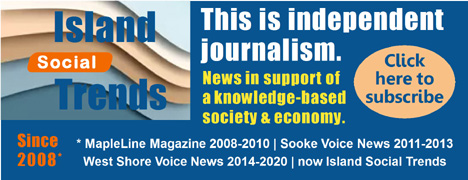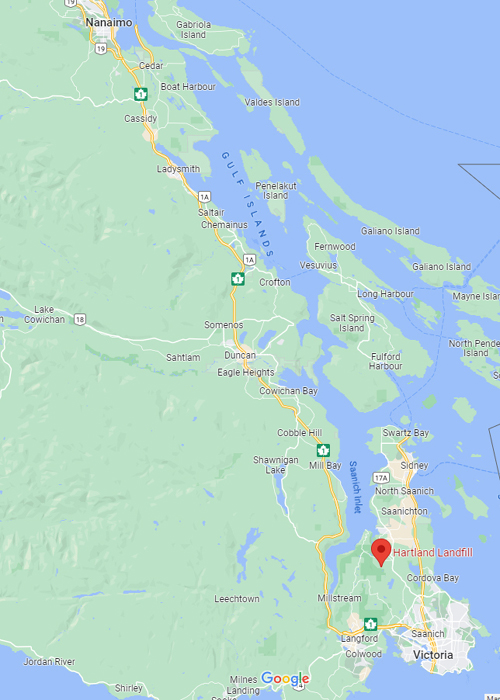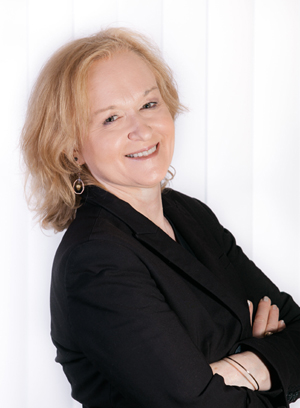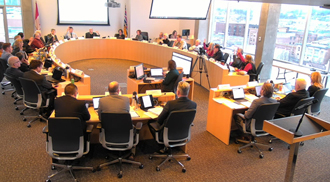
Thursday February 9, 2023 | VICTORIA, BC [Updated March 2, 2023]
by Mary P Brooke | Island Social Trends
UPDATE MARCH 2: It has now been revealed that due to an error in a CRD staff report, there was no arrangement with Nanaimo to accept biosolids from Victoria. That makes the lengthy discussion at the CRD February 8 board meeting somewhat invalid. Discussions are reportedly continuing between CRD and Nanaimo regarding options. CRD’s Hartland Landfill has been, meanwhile, accepting biosolids during a period when the Lafarge processing plant on the mainland has not been able to receive shipments.
At their February 8 board meeting, the Capital Regional District (CRD) board approved the shipping of biosolids to a facility in Nanaimo. The material would be applied to non-agricultural land.
The weighted vote (some municipalities get more vote weight than others on sensitive motions like this, and where only some municipalities would be directly affected) went through by a slim margin: 37 in favour, 31 opposed. [See Feb 8, 2023 meeting agenda and archived livestream]
The trucking of biosolid waste pellets from Hartland Landfill, along the highways (Hwy 17 and Hwy 1) through Saanich, View Royal and Langford and up the Malahat through Mill Bay, Duncan and other communities on its way to Nanaimo, holds the potential risk for spillage along the way.
Long debate:
The board debated for a fairly long while (over 1.5 hours) the pros and cons of this step to manage the amount of landfill material.
According to the motion that passed, the trucking option is to be temporary, while CRD awaits the renewed availability of barge shipping of solid waste by Lafarge for burning at their cement plant in the Vancouver lower mainland.
Solid waste is shipped elsewhere (now temporarily to Nanaimo and otherwise to Vancouver and destinations beyond as well) so as to help maintain capacity at the Hartland Landfill in Saanich.
The motion that the CRD passed yesterday includes approval of non-agricultural land application of biosolids, which concurs with the BC provincial regulation on these types of things. That doesn’t make it necessarily safe, some CRD directors argued.
Who voted against:
Residents of the Capital Region may find it important to note who had environmental concerns and therefore did *not* support the motion to send biosolids to Nanaimo: Scott Goodmanson (Langford mayor); Barb Desjardins (Esquimalt mayor), Sid Tobias (View Royal mayor), Doug Kobayashi (Colwood mayor), and three Victoria reps (Mayor Marianne Alto, Jeremy Caradonna, Dave Thompson).
They expressed concerns about not looking at other possible options for re-use of the biosolids, such as a suggestion by View Royal Mayor Tobias about making biochar.
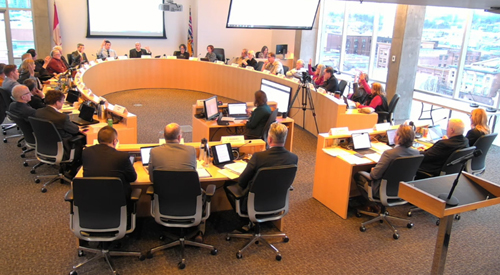
Esquimalt Mayor Desjardins led the waste management committee and debate for many years during the sewage treatment plant project development, and was concerned about the direction of yesterday’s decision-making.
Councillor Caradonna chairs the current environmental committee that came up with the recommendation to not ship the biosolids upisland. The board effectively turned down the work of the committee.
Who was okay with the trucking:
Here’s who was okay with the expediency of sending CRD-area biosolids waste by truck to Nanaimo, as evidenced in their points made at the board table: CRD chair Colin Plant, Saanich councillor Susan Brice, and Sooke Mayor Maja Tait.
Plant and Brice took the approach of ‘business as usual’, saying that reviewing other options would take too long.
Tait played on emotional obligation, saying that Nanaimo is helping out CRD in a pinch (until barge for shipping off-island is available again).
CRD directors who voted in favour of the short-term trucking motion were also concerned about not promptly complying with some provincial requirements about making sure the current biosolids production at Hartland does not seep into local waters or agricultural land.
Biosolids at Hartland:
The Hartland Landfill (on Hartland Avenue, west of West Saanich Road, about 14 km northwest of Victoria) is home to the Capital Regional District’s (CRD) Residuals Treatment Facility, which came online in summer 2020.
The Residual Treatment Facility (RTF) was built over a period of five years and was part of the CRD’s $775 million Core Area Wastewater Treatment Project.
The RTF is intended to reprocess some of the region’s waste. Instead of pumping treated waste into the ocean, Greater Victoria sewage would instead be turned into biosolids that resemble tiny pellets that could be sent to the Lafarge cement plant in Richmond, B.C., to be burned as fuel.
Goal of diversion:
The CRD established a local service for solid waste disposal in 1973.
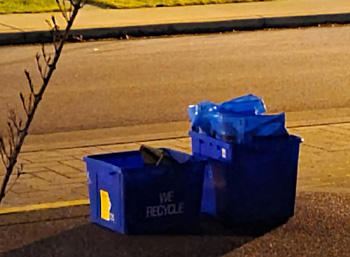
Environmental resource management in the Capital Region is based on the 5R hierarchy of Reduction, Reuse, Recycling, Resource Recovery and Residual Management with the goal of extending the life of Hartland Landfill by minimizing waste disposal and maximizing diversion opportunities.
At the present rate, Hartland Landfill capacity is expected to be available to 2050. To help achieve that, CRD has a rigorous recycling program. Meanwhile, curbside blue box pickup has been experiencing delays and has been below capacity for several months, due to a labour shortage.
A solid waste management plan is a legally mandated document by the Province of British Columbia. The current CRD Solid Waste Management Plan was submitted to the Province of BC for approval in August 2021 and is pending approval.
===== ABOUT ISLAND SOCIAL TRENDS:
Island Social Trends emerged in mid-2020 from a preceding series of publications by founder/editor Mary P Brooke and published by Brookeline Publishing House Inc, covering news of the south Vancouver Island region, BC and national issues through a socioeconomic lens.
The publication series began with MapleLine Magazine (2008-2010), then morphed to a weekly print newspaper Sooke Voice News (2011-2013), and then into the weekly PDF/print West Shore Voice News (2014-2020). The news at IslandSocialTrends.ca (2020 to present) is entirely online.
ARCHIVES: POLITICS | HEALTH | EDUCATION | ENVIRONMENT & SUSTAINABILITY



